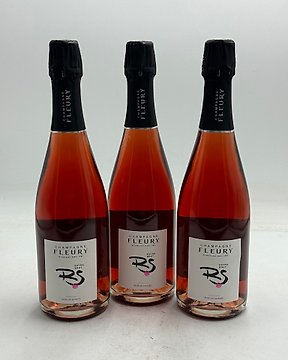
fleury, Fleury Rosé de Saignée - Champagne Extra Brut - 3 Flessen (0.75 liter)
Nr. 84441139

Nr. 84441139

Shipped insured with DHL-Express
Champagne La Closerie is a tiny grower founded in 1998 by Jérôme Prévost which has gained something of a cult following for its Pinot Meunier-based Champagnes. These are sometimes listed under the winemaker's name.
Prévost took over his grandmother's Lés Beguines vineyard with 2.2 hectares (5.4 acres) of Massale selection (Pinot) Meunier, located in the village of Gueux in the Montagne de Reims. A few vines of Pinot Noir, Pinot Gris and Chardonnay are dotted around the property, and make up around 5 percent of final blends.
Previously, the vines had been rented out until 1987, when Jérôme began to manage them, selling grapes directly to négociants. In the mid 1990s he also began working at Jacques Selosse, and Anselme Selosse encouraged him to make wine from his own vines, beginning in 1998.
As Prévost had nowinemaking facilities, the wines were made at the Selosse cellars in Avizes until 2001. For the 2002 harvest he moved production to Gueux, initally in a garage behind his home. In 2018 he moved into a modern minimalist home and winery at the edge of Les Béguines.
Terroir and production methods
Production is focussed on site-specific bottlings primarily focussed on one grape variety and one vintage. Yields are extremly low at around half the permitted level.
Soils at Les Béguines are light Thanetian sand and clay-limestone over chalk bedrock. The site lies at an altitude of 120m (390ft).
The soils are partially hand-ploughed. No herbicides or insecticides are used, while sulphur and copper are used against mildews and fungicide might be sprayed in extreme situations.
Ferments of the base wine are carried out with indigenous yeasts in a mix of new and used barrels of various sizes from 225 to 600 liters. Champagnes are disgorged 14 to 17 months after bottling. Very little sulfur is added, in order to express the terroir and vintage variation.
The 14-17 months sur lattes, where the wine lies in bottle undergoing its second fermentation and yeast autolysis, is unusually short. However Jérôme Prévost believes that more interesting evolution occurs after disgorgement as the "finished" sparkling wine matures. He feels the wines tend to need around six years from vintage to open out.
Estate-grown wines
The main bottling is Les Béguines, which is roughly 90 percent Pinot Meunier with the remainder taken up by the other three varieties grown in the vineyard. The still wine is aged in oak for ten months. The dosage is around 2.5 grams per liter sugar.
An Extra Brut rosé called Fac-simile is also produced. It has a dosage of 2 to 3 g/l, and a component (around 13 percent) of still red Meunier from Les Béguines and is aged in 228-liter Burgundy pièces. Occasionally, experimental cuvées have also been released to the market.
Negociant wine
Since 2020, concerned with extremes of weather and effects on yields, Prévost has also started a micro-négociant operation. His existing Les Béguines cuvée and tiny amounts of "Fac-similie" rosé have been joined by a new La Closerie Extra Brut non vintage wine.
Since 2020, concerned with extremes of weather and effects on yields, Prévost has also started a micro-négociant operation. His existing Les Béguines cuvée and tiny amounts of "Fac-similie" rosé have been joined by a new La Closerie non vintage wine.
The new La Closerie bottling comes from a handful of plots on the same sandy soils as Les Béguines. Some are maneged by Prévost and his team, some by the owners. Harvest and sorting are controlled by Prévost. The 2020 release was composed of 80 percent 2018 and 20 percent 2017 base wines.
Zo koop je op Catawiki
1. Ontdek iets bijzonders
2. Plaats het hoogste bod
3. Veilig betalen